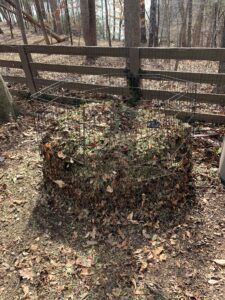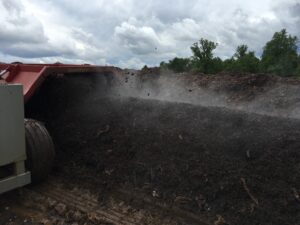Composting is a great way to recycle organic wastes like food and yard waste. It uses natural decomposition to create a valuable soil additive while keeping the waste out of landfills where its decomposition creates methane. Since about 20% of landfilled waste in Virginia is compostable, increasing composting makes sense economically and environmentally.
Compost is the result of the decomposition of organic materials like food and yard waste into a rich, dark, soil-like substance called humus. The decomposition is done by organisms including bacteria, protozoa, fungi, beetles and earthworms, depending on the process used.
How to do it
While organic matter will decompose over time under most circumstances, a few practices speed the process:
- Create compost batches out of a mix of high carbon (brown) and high nitrogen (green) inputs. Typical browns include yard wastes like leaves, hay and straw, wood chips and sawdust. They can also include household wastes like food-soiled napkins, paper towels, shredded non-glossy paper and cardboard and hair. Greens can include grass clippings, green garden waste, fruit and vegetable scraps, coffee grounds, paper tea bags and eggshells.
- Conventional home compost bins should not include meat, grease, bones, dairy products, oils and egg yolks. They take longer to decompose and can attract varmints. Never use pressure treated wood sawdust or shavings, coal or charcoal dust, black walnut leaves/twigs or herbicide treated or diseased plant waste.
- To achieve “hot composting”, which can reach temperatures of 130 degrees or more, create batches where the ratio is about 2 to 3 times the amount of browns to greens by volume. Hot composting provides the fastest decomposition while helping to kill weed seeds and pathogens.
- Cut materials into small pieces to increase the speed of decomposition. This increases the surface area for microbes to attack. Chop up kitchen waste and mulch grass and leaves to help the process.
- The batch should be aerated by turning it regularly, typically weekly. As materials break down the batch will settle, forcing air out of the pile. This changes decomposition from aerobic (oxygen fed) to anaerobic (without oxygen) which is smelly and produces methane, a greenhouse gas.
- Compost batches should be moist but not drippy. While aerating, check moisture. Add water if it looks dry. If it is dripping wet, increase aeration frequency and cover it if rain is expected.

- A good size compost batch is a 3- or 4-foot cube. This is small enough to manage but large enough to provide the insulation necessary for the core to reach the desired high temperatures. Smaller batches will still decompose and yield a good product but will take longer to break down and are more likely to sprout weeds. Time from initiation to completion of a compost batch can be from 3 or 4 months to a year or more depending on input mix and management. It is ready when the material is loose, dark, rich smelling and the inputs are no longer recognizable.
- If you add to the pile during the process, screen the material before using new compost to separate finished compost from less decomposed, newer inputs that require further processing.
Additional information is available in the Virginia Cooperative Extension publication Making Compost from Yard Waste.
Benefits and Application
Compost benefits soils by adding organic matter and the soil organisms that make soil nutrients available to plants. It loosens fine soils like our local clay, allowing easier water entry, while providing absorbency that helps hold moisture longer in our sandy coastal soils. Good ways to apply it include:
- In new beds, spread a couple of inches on the surface and till it in to loosen and enrich the existing soils
- For established beds, spread it on top or work it into the soil surface, letting soil organisms carry it deeper over time.
- Enrich potting soil by adding about one-third compost to your favorite mix
Options for Restricted and Limited Spaces
If your situation isn’t suitable for an outdoor open composting setup, there are other options:
- Closed bins for outdoor composting are sold at big box stores and on-line. Look for a capacity that reflects the quantities of material you have available, easy entry and extraction and a convenient aeration method, by barrel rotation for example. Then follow the guidelines above for materials, aeration and moisture. Closed containers are neat and eliminate odor and varmint risks so are good in restrictive situations.
- Vermicomposting uses special earthworms to eat and excrete fruit and vegetable wastes mixed with shredded paper and/or leaves to create nutrient and microorganism rich “castings” a great soil amendment. It can be done cleanly and is a good solution for apartment dwellers. The worms require temperatures in the 65-70 degree range. This EPA publication provides “how-to” details.
- Bokashi composting is a Japanese technique that ferments kitchen scraps, including meat and dairy items, with an inoculant that includes wheat germ/bran or sawdust with molasses and micro-organisms found in healthy soil. The organic material and inoculant are layered in an airtight bucket with a spigot at the bottom to drain leachate. The materials are pressed to squeeze air out and allowed to ferment for a couple of weeks. The leachate can be drained and diluted by about 100:1 and used as a fertilizer. The solids are not actually compost yet, but when mixed into soil are rapidly decomposed by soil organisms to form humus, a long lasting, highly beneficial soil amendment. The process is quick, provides good soil benefit while reducing landfilled organic waste and is relatively inexpensive. Buckets can be purchased or home-made for about $50 per copy and the inoculant costs about $8-10 per month depending on the volume of material processed. It can be done in a garage which keeps it out of the residence and allows it to go forward year-round. A thorough writeup describing Bokashi Composting is presented by the NC Cooperative Extension.
- Countertop Composters are another possibility. Be careful however, to be sure you know what you are buying. Some items called countertop composters are nothing more than food waste collection bins. There are, however, electrically powered devices that heat, aerate, grind and mix food wastes and other compostable inputs, generally with a proprietary probiotic tablet or powder, to produce a product that can be added to soil or a compost bin where relatively quick decomposition will occur. Where Bokashi requires a couple of weeks for fermentation to run its course, these units provide a ground up material in a matter of hours. Manufacturers may call the product compost or dirt, but in fact the output is neither. It does however provide a first step in creating a beneficial compost and reduces the landfilling of food and other organic wastes. Cost of the units is up to $500 and cost of inoculant and carbon filters (desirable since the units sit on kitchen counters) can run about $40 per quarter. I haven’t been able to find non-commercial information on these products but there is info available on-line under countertop composters.

- If you want to compost food waste but can’t compost it yourself, consider dropping it off, in the greater Charlottesville area, at the McIntire Recycling Center or the Ivy Material Utilization Center.
- For Charlottesville residents, there is a drop-off at City Market and a few locked locations that residents can access via pass codes in and around the city.
- There is also a local composting company, Black Bear Composting, that will perform residential pickup for a monthly fee and in return provide complementary finished compost on a periodic basis.
Composting is a pure good thing. There are many ways to approach it, at least one of which can work for almost everyone. Why not give one of them a try?!!!